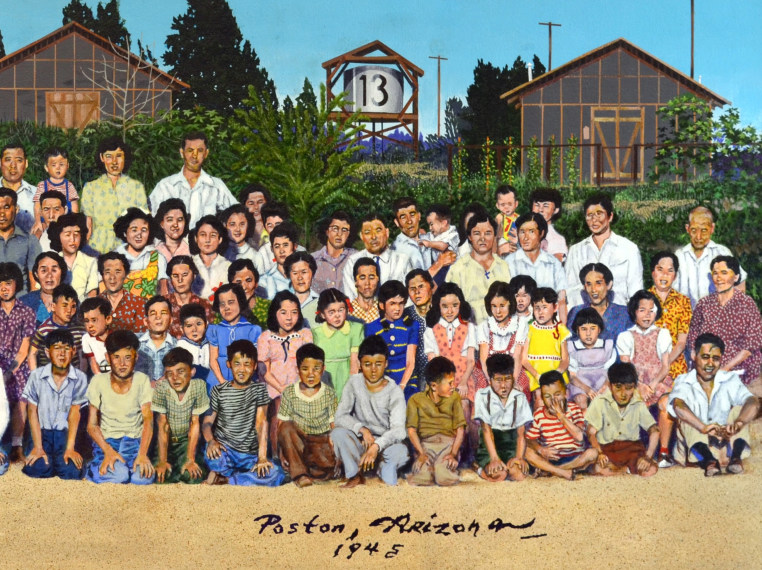
Photo: Timothy Doyon, Courtesy of Ortuzar Projects
Photo: Timothy Doyon, Courtesy of Ortuzar Projects
Photo: Timothy Doyon, Courtesy of Ortuzar Projects
Photo: Timothy Doyon, Courtesy of Ortuzar Projects
Photo: Timothy Doyon, Courtesy of Ortuzar Projects
Photo: Timothy Doyon, Courtesy of Ortuzar Projects
BEN SAKOGUCHI: MADE IN U.S.A.
February 7, 2020 – March 12, 2020
Opening Reception: February 7, 2020, 6-8 pm
Ortuzar Projects is pleased to present Ben Sakoguchi: Made in U.S.A., featuring paintings produced during the past fifty years.
Sakoguchi’s acerbic style melds elements of figuration, history painting, and Pop in works that critique American cultural values and ahistorical Californian idealism. By turns sentimental and brutal, his work intertwines storybook American political history with the personal narratives that prove the lie of exceptionalism, and is informed by his own biography as a Japanese-American citizen during World War II, when he and his family were incarcerated in an internment camp, and the excesses of the post-war era.
After completing graduate studies at UCLA in 1964, Sakoguchi became associated with the emerging painters around Cecil Hedrick and Jerry Jerome’s Ceeje Gallery. Located at the far end of La Cienaga Boulevard’s gallery row, Ceeje supported a vibrant program of eccentric, mythic, and personally intimate figuration—a contrast to the cool conceptualism consolidating in Southern California at Ferus Gallery. Sakoguchi first experimented with multi-part paintings and modular canvases in the late 1960s, eventually discovering the serial and clustering conventions that define his practice. The density and intensity of Sakoguchi’s early work drew comparisons to Hieronymous Bosch in their delirious portrayals of consumerist abundance bolstered by state violence and exploitation.
Sakoguchi is best known for the series Orange Crate Labels, begun in the mid-1970s and later reprised in the mid-1990s. These 10x11-inch panels borrow their format from commercial illustrations found on wooden crates, which espoused the virtues of citrus and the values of its growers. As a child, Sakoguchi regularly observed stacks of crates in the grocery run by his parents in the “Orange Empire” of the San Bernardino Valley. Each panel appropriates the basic elements of a vintage label—a title set in alluring typeface that also names a particular brand or variety, the word “orange,” and an image of the fruit—brought together in an inspirational composition of ambiguous ideology and questionable perspective. Sakoguchi’s acrylic-on-canvas works repackage objects of satire in the language of fresh produce, ripe for the selling. Whether the artistic movement of postmodernism, David Duke of the Ku Klux Klan, iconic images of the Vietnam War, or a local crew of Surf Nazis, these repeated invocations of racism, xenophobia, and militarism in Orange Crate Labels provide dark commentary on the bounty of the Golden State.
The exhibition also features works from Bombs, 1983, a series comprised of mostly single-panel diptych airbrush paintings, made over four months during a period of tense political escalation in the Cold War. Drawing on imagery produced by scientific and clinical researchers for the U.S. military, the “hard-edge” realism is a searing indictment of nuclear armament—a condemnation shared by his colleague and friend Vija Celmins. The more recent suite of 15 panels, Towers, 2014, renders the surveillance systems and austere structures of the camps where Japanese residents and US citizens were incarcerated during World War II. Sakoguchi has remembered his time interned in Poston, Arizona, as a place of “mostly browns and grays.”
Ben Sakoguchi (b. 1938, San Bernardino) lives and works in Pasadena, California. He retired as professor at Pasadena City College in 1997, where he taught for more than three decades. After retreating from the commercial art world in the 1970s, he continued to exhibit in university art galleries, museums, and other non-profit spaces in Southern California and the United States.
He has exhibited solo projects at POTTS, Alhambra (2018), The Skirball Center, Los Angeles (2016), The Alternative Museum, New York (1992), and San Francisco Fine Arts Museum, San Francisco (1980). His work has featured in institutional surveys and group exhibitions including L.A. RAW: Abject Expressionism in Los Angeles, 1945–1980, Pasadena Museum of California Art, Pasadena (2012), Sub-Pop, Cardwell Jimmerson Contemporary Art, Los Angeles (2011), Made in California: Art, Image, and Identity, 1900-2000, Los Angeles County Museum of Art, Los Angeles (2000), and The Decade Show: Frameworks of Identity in the 1980s, The New Museum, The Museum of Contemporary Hispanic Art, and The Studio Museum, New York (1990). He was twice awarded fellowships by the National Endowment for the Arts.
